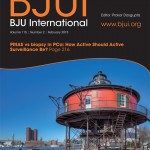Video: Holmium Laser Enucleation and Photoselective Vaporization of the Prostate for Patients with Benign Prostatic Hyperplasia and Chronic Urinary
Holmium Laser Enucleation and Photoselective Vaporization of the Prostate for Patients with Benign Prostatic Hyperplasia and Chronic Urinary Retention
Christopher D. Jaeger, Christopher R. Mitchell, Lance A. Mynderse and Amy E. Krambeck
Department of Urology, Mayo Clinic School of Medicine, Rochester, MN, USA
OBJECTIVES
To evaluate short-term outcomes of holmium laser enucleation of the prostate (HoLEP) and photoselective vaporisation of the prostate (PVP) in patients with benign prostatic hyperplasia (BPH) and chronic urinary retention (CUR).
PATIENTS AND METHODS
A retrospective chart review was performed of all patients with CUR who underwent HoLEP or PVP at our institution over a 3-year period. CUR was defined as a persistent post-void residual urine volume (PVR) of >300 mL or refractory urinary retention requiring catheterisation.
RESULTS
We identified 72 patients with CUR who underwent HoLEP and 31 who underwent PVP. Preoperative parameters including median catheterisation duration (3 vs 5 months, P = 0.71), American Urological Association Symptom Index score (AUASI; 18 vs 21, P = 0.24), and PVR (555 vs 473 mL, P = 0.096) were similar between the HoLEP and PVP groups. The HoLEP group had a larger prostate volume (88.5 vs 49 mL, P < 0.001) and higher PSA concentration (4.5 vs 2.4 ng/mL, P = 0.001). At median 6-month follow-up, 71 (99%) HoLEP patients and 23 (74%) PVP patients were catheter-free (P < 0.001). Of the voiding patients, postoperative AUASI (3 vs 4, P = 0.06), maximum urinary flow rate (23 vs 18 mL/s, P = 0.28) and PVR (56.5 vs 54 mL, P = 1.0) were improved in both groups.
CONCLUSIONS
Both HoLEP and PVP are effective at improving urinary parameters in men with CUR. Despite larger prostate volumes, HoLEP had a 99% successful deobstruction rate, thus rendering patients catheter-free.



